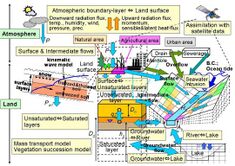Hydrological modelling: различия между версиями
| Строка 56: | Строка 56: | ||
5. HYDROLOGIC MODELING. Current Status and Future Directions // National Institute of Hydrology, Roorkee, 2018 | 5. HYDROLOGIC MODELING. Current Status and Future Directions // National Institute of Hydrology, Roorkee, 2018 | ||
| − | 6. Ramadhan K., Supriatna Erosion rate prediction model ssing SWAT and CA-Markov methods (case study: Upper Ci Catih Catchment Area) // IOP Conference Series: Earth and Environmental Science. – 2019. – | + | 6. Ramadhan K., Supriatna Erosion rate prediction model ssing SWAT and CA-Markov methods (case study: Upper Ci Catih Catchment Area) // IOP Conference Series: Earth and Environmental Science. – 2019. – Vol. 311. <nowiki>https://doi.org/10.1088/1755-1315/311/1/012072</nowiki>. |
Версия 22:55, 25 апреля 2024
Термин на русском
Моделирование гидрологического процесса — создание моделей, воспроизводящих отдельные стороны гидрологического процесса. Гидрологический процесс — процесс формирования гидрологического режима. Гидрологический режим — совокупность закономерно повторяющихся изменений состояния водного объекта, присущих ему и отличающих от других водных объектов. [1]
В целом, все модели можно поделить на три основные группы:
1. Эмпирические модели. Данное название такого направления связана с тем, что для моделей используются лишь входные и выходные данные, а все происходящее на изучаемом участке остается за пределами модели. Примером такой модели является Стэнфордская модель или модель черного ящика [2].
2. Концептуальные модели. Модель может быть создана при неполном содержании физических представлений о гидрологической системе, но при этом наличии некоторых зависимостей и связей, которые определят структуру модели или ее параметры. Зачастую используют наиболее доступные физические данные, например, температуру и осадки. Примерами концептуальных моделей являются модели HBV, ECOMAG, SWAP. [2].
3. Физико-математические модели формирования стока. Данный тип моделей используется в случае, когда имеются достаточное полные физические представления, в результате чего, параметры модели могут быть вычислены через физические константы. Примером такой модели является SHE. [2].
Существует другая классификация гидрологических моделей по типам параметров:
1. Модель с сосредоточенными параметрами
2. Модель с распределенными параметрами
Определение на английском
The use of small-scale physical models, mathematical analogues, and computer simulations to characterize the likely behavior of real hydrologic features and systems. [3]
In general, all models can be divided into three main groups:
1. Empirical models. The title of this approach is associated with the fact that these models use only input and output data, while everything happening in the studied area remains beyond the model's scope. An example of such a model is the Stanford model or black box model [2].
2. Conceptual models. A model can be created with an incomplete understanding of the physical aspects of the hydrological system but with the presence of certain dependencies and relationships that determine the model's structure or its parameters. Often, the most readily available physical data, such as temperature and precipitation, are used. Examples of conceptual models include HBV, ECOMAG, SWAP [2].
3. Physically-based hydrological models. This type of model is used when there is a sufficiently complete understanding of the physical processes, allowing model parameters to be computed using physical constants. An example of such a model is SHE [2].
There is another classification of hydrological models based on the types of parameters:
1. Models with lumped parameters.
2. Models with distributed parameters.
Пример использования термина на английском языке
- A number of model intercomparisons have confirmed that the relatively simple conceptual model is an appropriate operational choice in hydrological modelling, maybe best illustrated by the well-controlled intercomparisons of hydrological models carried out by the World Meteorological Organisation (WMO, 1975 and 1986) [4].
- This study focuses on the hydrological modelling made by SWAT (Soil Water Assesment Tools) and landuse change prediction using CA-Markov (Cellular Automata-Markov Chain) to find the effects of landuse changes on the erosion rate changes. [6]
Перевод использования на русском языке
- Межмодельный сравнительный анализ подтвердил, что относительно простая концептуальная модель является оптимальным вариантом при гидрологическом моделировании, что, возможно, лучше всего показано экспериментами в исследованиях Всемирной метеорологической организацией (ВМО, 1975 и 1986 годы).
- Это исследование сосредоточено на гидрологическом моделировании, выполненном с помощью SWAT (инструментов оценки влажности почвы), и прогнозировании изменений в землепользовании с использованием CA-Markov (клеточных автоматов-цепи Маркова) для определения влияния изменений в землепользовании на скорость эрозии.
Список литературы
1. ГОСТ 19179-73 Гидрология суши. Термины и определения
2. Мотовилов Ю.Г., Гельфан А.Н. Модели формирования стока в задачах гидрологии речных бассейнов . - Москва: Российская академия наук , 2018
3. A Dictionary of Earth Sciences // edited by M. Allaby. 2008
4. Seibert, J. and Bergström, S.: A retrospective on hydrological catchment modelling based on half a century with the HBV model, Hydrol. Earth Syst. Sci., 26, 1371–1388
5. HYDROLOGIC MODELING. Current Status and Future Directions // National Institute of Hydrology, Roorkee, 2018
6. Ramadhan K., Supriatna Erosion rate prediction model ssing SWAT and CA-Markov methods (case study: Upper Ci Catih Catchment Area) // IOP Conference Series: Earth and Environmental Science. – 2019. – Vol. 311. https://doi.org/10.1088/1755-1315/311/1/012072.
